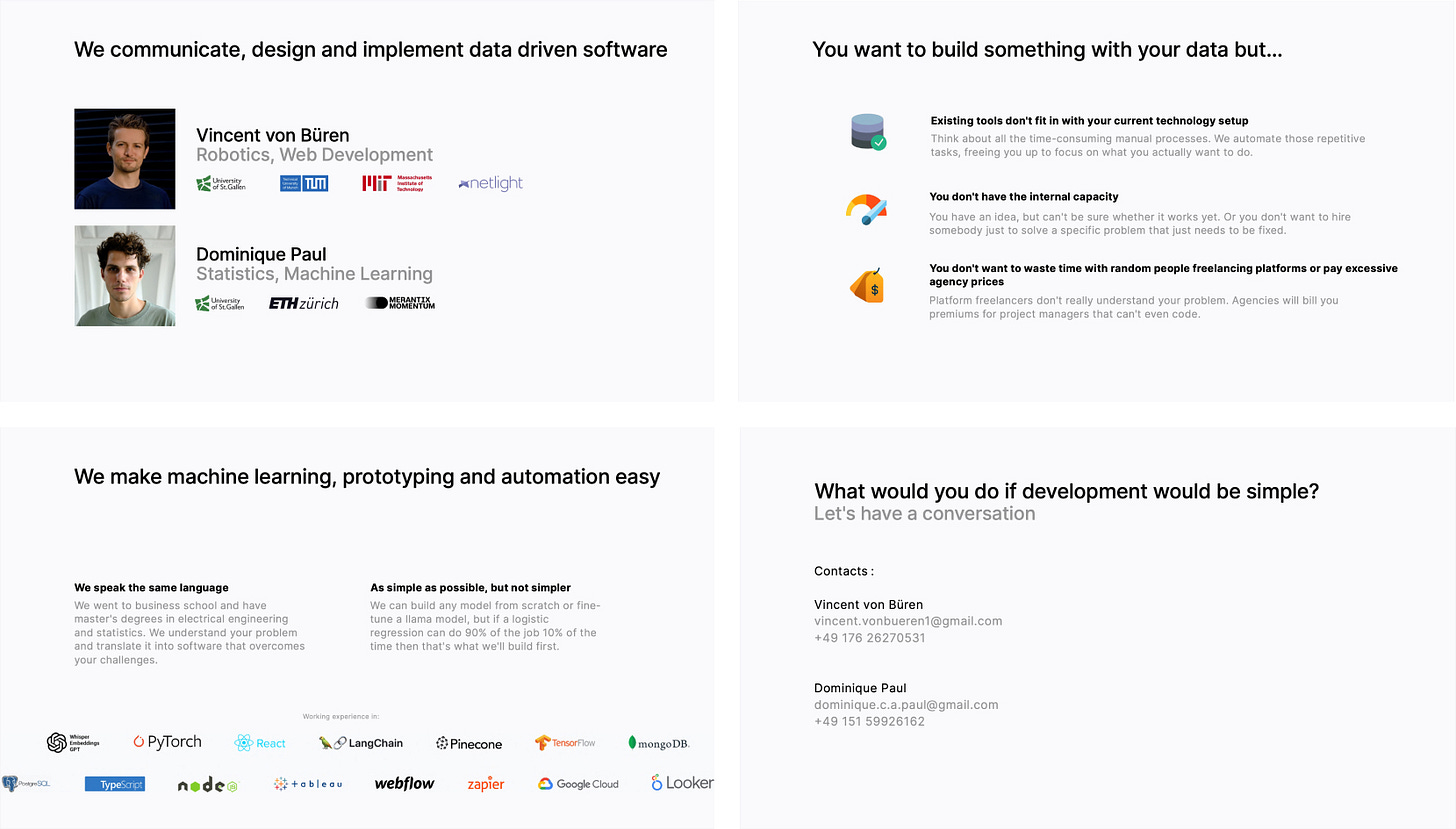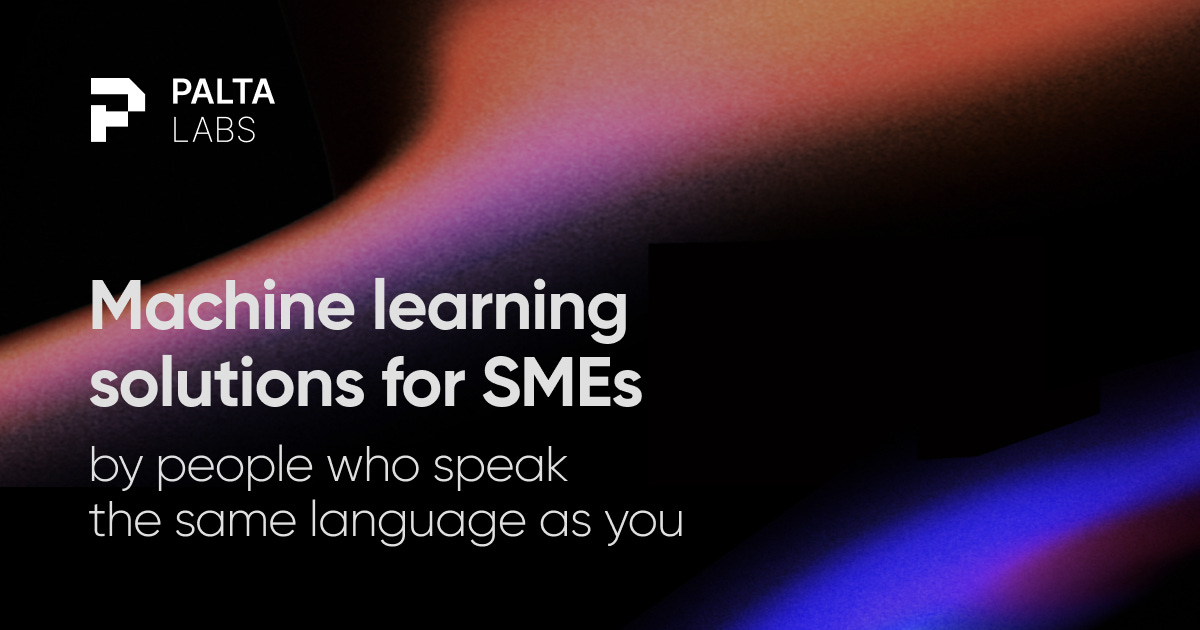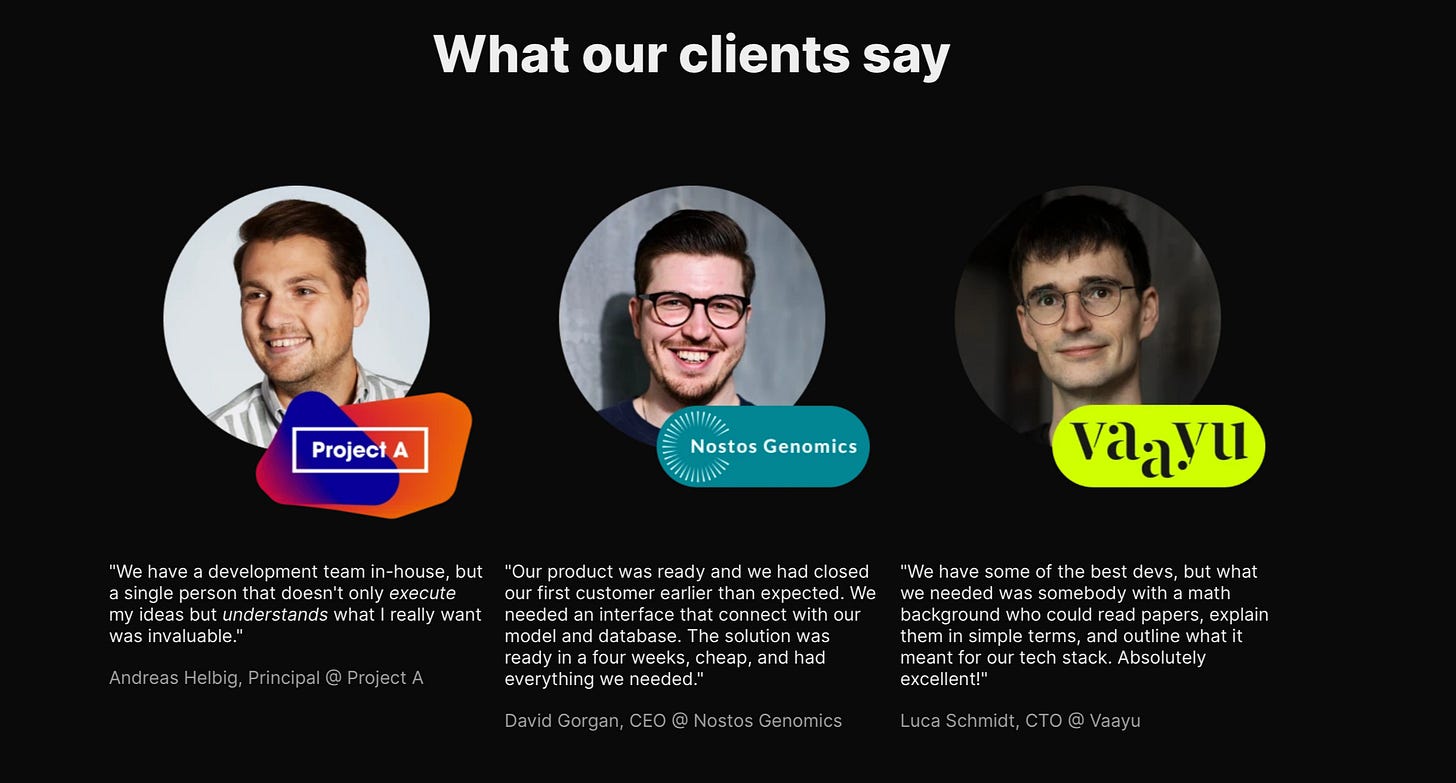Shelving data annotation in Sierra Leone and launching Palta Labs
Focussing on a problem first approach and and ML agency
Backdrop for the 12 new subscribers that have joined since my last email: A friend of mine, Vincent, and I both studied Electrical Engineering/Statistics after going to business school. But we are both frustrated that there aren’t jobs where you combine both skill sets to a value that is greater than the sum of the parts. We have decided to work together on our own ideas.
Building and selling digital literacy in Sierra Leone is operations-heavy
Last time I shared an idea Vincent and I were working on: outsourcing digital services to West Africa. You start with data labelling as the beachhead market and work up the skill ladder to eventually educate and sell software developers for hire. The idea builds on the enormous wage arbitrage between Europe and Africa and the fact that you can learn and sell these skills completely online. This also circumvents corruption and bureaucracy - the key drivers of transaction costs in many other industries in Africa.
We interviewed five people with backgrounds ranging from large-scale data labelling companies to people who have organised hackathons in 11 West African countries, including Sierra Leone.

We found out that the market is split into (A) ultra-high quality or long-tail data annotation sought by large tech and (B) basic commodity labelling, e.g. bounding boxes or text annotation. Market A requires access to professionals with niche skills and is neither interesting nor attainable in West Africa. Market B is highly competitive and has been so for several years now. Key differentiators are (1) price, (2) quality of the data, (3) professionalism and communication, and (4) data security such as GDPR compliance.
We also found out that Sierra Leone would have an incredible price advantage, even compared to companies in countries like Uganda and Kenya. Sama, a big player active in Uganda that helped train GPT3, pays their workers $3.50 to $8.00 per hour. Workers in Sierra Leone would be in the top earning bracket if we paid them $5 per day. That’s a 6-13x price advantage. Interviewee 4:“They would stand in line for such a job if you paid them that. […] Digital literacy is low in Sierra Leone but individuals can easily learn to use a laptop and how to label data”.
Most of the value is captured in an operations centre
Our biggest advantage is in organising and selling the labelling power (just considering this beachhead market for now). Making a sale to customers who want to get their data labelled is highly competitive. It’s hard to add value here or differentiate ourselves. Labelling has become a commodity and the key differentiator is your price.
So what’s best? Ideally, you’d just organise labour with a sufficient level of quality assurance and sell it to the platforms already making the sale. Over time you can try and make your own sales. This first step makes the business very operations-heavy. The operations part does not disappear over time. Business success depends on how well you organise the labelling centres in Sierra Leone. And for that, it’s essential to live there.
And that’s why we decided to shelve the plan. At least with this beachhead structure.
Our comparative advantage is our combination of electrical engineering/ML capabilities combined with our business background. In the business model above we would barely leverage any of these skills.
Also, we are fine with spending a considerable amount of time in West Africa, but with this ops-heavy structure, there’s virtually no value in being anywhere else. There’s no bridge we can create between the two continents. It’s more of a modern version of an Indian business processing centre. I would invest money in such a business, but I can’t imagine investing the next 3+ years of my life like that.
The idea of teaching people in low-income countries to code is an idea that is still turning in my head, but data labelling is not an attractive beachhead market. The problem is a Rubik’s cube that I am turning in my hand, looking at each side again and again, not knowing what the right change is, but knowing that there is a solution. I’m not completely done with this topic, but it will take some time to develop these thoughts further.
Now that the idea is shelved, what’s next?
Start with the problem, not the solution
We noticed that we were running into the risk of spitballing ideas on our weekly call. But wait, why are Vincent and I talking in the first place?
We want to work on something that we care about and enjoy so much that we’d like to do so for 5+ years. We shouldn’t be looking for problems that we could solve, but think about problems we already care about.
It’s easier to start with a problem that you might not know how to solve than to start with a skill or experience and find a product. Caring about a problem is the biggest unfair advantage you can have to solve it. And ultimately, problems are the delta between the world as it is and how the world could be for the better.
It’s hard not to care about problems if they annoy you every day. In the five months in Sierra Leone, there were a lot of things that annoyed Tata and me. Congested traffic, the pain of importing two container batches, the time wasted on just getting cash, and having to transport all the goods yourself because you couldn’t trust anyone to handle them. I often think of my favourite quote from William Gibson:
The future is already here – it's just not evenly distributed.
Every day you see so many problems. You have so many ideas on how to solve them and often personally know the people who would be helped. What’s hidden though is the problem of making your solution work for the local culture. Africa is a continent where, perhaps more than anywhere else, business can do well by doing good. But it’s not as easy as copy-pasting from other places.
We chose digital education in Africa to start with and will analyse the topic by looking at trends across five dimensions: technological, societal & environmental, legal & political, economic, and business model trends.
But passion also originates from doing
There are a lot of problems that we aren’t aware of. We should be exposing ourselves to more of them. That’s why we have decided that we will be freelancing together. Specifically, we’re building data-driven products as a service under the name Palta Labs. This is us.
Quite some thoughts, conversations and time have gone into this by now. Instead of describing the path chronologically I want to share what I found out along the way. I’ve put together five learnings. Things that I would do differently if I were to start at 0 again.
1) Our key differentiator is our business background
This learning goes back to 2018 when Andy, my boss at Project A, explained to me why he preferred working with me over the in-house dev team. I was getting things done on my own because I couldn’t only implement what we had discussed in our last meeting but also the next steps because I understood what he ultimately wanted to achieve and didn’t have to stop and get feedback first.
The world isn’t waiting for another software development agency. But the problem that we’re solving is significantly lowering the bar for people who have a problem but can’t assess what it takes to build it. These will initially be 1st and 2nd degree connections. They know that we can understand their business problem but can write the code.
A lot of developers focus on writing good code. Once you describe a problem they think about the best architecture to solve the problem. We also consider architecture design, but we don’t care about building unnecessarily complicated solutions. We care about solving your problem. If a hugging face model solves 80% of your problem, we won’t build a model from scratch.
People don’t care about fancy technical solutions but just about getting their problems solved.
2) Use a website template
We first wanted to make our value proposition as personal as possible and started with a four-slide pitch deck. No agency name, just our names and pictures on the first slide.

But some issues were quickly apparent: Once sent we couldn’t make any edits or add slides from feedback others had given us. We also weren’t aware whether other people were forwarding the deck or not and whether we might be getting a high reach, but no conversions into conversations. The barrier to contacting us - if you received the deck from someone else - was also very high, even though we tried to mitigate that by adding our phone numbers and making emails clickable.
After a week it was clear that a website would be easier. People just need to share a link or can even Google us. We can track website clicks, and edits after sharing the link are visible whenever the website is opened again.
We also decided to give it a proper name. I don’t like the word “agency” because that’s not what we're striving to be. We just want to work on some cool problems.
For the website I wanted something simple. We started building the website with Typedream, but its limited editing functionality was frustrating. We use Webflow for the Sierra Leone Hockey page, but it felt like too much for our initial one-page website. I decided to use Framer because its interface is a bit like Figma. I wanted to recreate the template from Typedream that I started with but make some edits.
After a lot of work, I am still not 100% happy with our website. Some things just don’t fit together. I’m ok with design, but it takes me too many iterations before all components fit together as they should. This has consumed a lot of time which is great for learning, but to launch again quickly I would just use a Framer template. Find a website that roughly fits your story’s structure and then use as many pre-built components as possible.
3) People want to see faces
We initially didn’t include our faces on the website. We were afraid that it would make Palta Labs look less professional because we were only two people. But people do business with people they know, like, and trust.
Actually, some people liked that we were such a small team. And it somehow is cool that it's just the two of us. We didn’t just add our faces but also talked to former customers (I already did 4 freelance projects before) and got some quotes from them that we could put on the website.
4) Don’t just share it with people, make it a conversation
Initially, we thought that sharing it with ~50 people might be enough to land a first project. But while we got some kind feedback along the lines of “Super cool, I will keep it in mind” it didn’t amount to much more. Instead, what helped was initiating a conversation about the topic.
The most useful conversations for getting leads for projects were the ones where I asked friends for feedback. A good example was my flatmate Tobi who cofounded Nelly, a company digitalising doctors’ offices. He gave me feedback on our deck but said that they didn’t have anything at Nelly that would make sense for us to work on. We then talked about his day and 10 minutes later he talked about how a big pain they currently have is building a data integration to load files from a medical group’s data platform.
Wow. We talked about our deck for 20 minutes and he didn’t make a connection. Something wasn’t right with our deck and approach yet.
We understood that longer conversations made it easier for people to fully understand what we do and why. It helped us learn what our pitch was lacking and how we could tailor it to our target group. Also, it gave space to the other person to talk about their problems.
5) Specialising makes it easier to market yourself
The last point also ties into this one. The most common question I got from the first 10 conversations about Palta Labs was “So what exactly could you build?". It’s a very easy but also a very hard question.
We have worked on a diverse range of projects ranging across building control systems software for robot arms; web apps to allow laboratories to upload their lab data to a platform and have it analysed for rare genetic diseases; WhatsApp chatbots that transcribe, summarise and edit voice memos and send them out as physical letters; models that segment rooftops for solar panel placement from satellite data; prediction models for VC funds that classify start-up quality and more.
Most problems in businesses aren’t too far away from what we’ve done so far. But “we can do everything” is a very bad answer to the question of what we can do. We’ve started narrowing it down to machine learning and data (excluding web apps, DevOps, etc.), but ideally, we should narrow it down even further. We should also add more specific examples that can spark ideas and allow viewers to draw connections to their own problems.
This would also make it easier to approach customers.
“Hey, we are two engineers that can solve any type of data problem you most likely have. Is there anything you need help with?” is not a good start to a conversation.
The challenge ahead: Awareness
My current hypothesis is that the problems we want to work on occur on multiple occasions in small companies.
But the knee-jerk reaction isn’t for people to seek someone outside the org to help them solve it, but rather find a workaround, just live with the problem, or even discard the project completely if the technical problem is insurmountable to them.
For these problems, people won’t look for solutions once they encounter a problem. I believe that we need to create awareness about what we are doing such that people think of us in the moment when they encounter a problem and make reaching out to us as easy as possible.
I’d love to hear your opinion on what we’re doing and how we should go about acquiring customers. Especially if your opinion differs from mine. Send me a WhatsApp (if you have my phone number) or email (dominique@palta-labs.com).
My Top Reads of the Week
1 - We won 10.000€ for hockey in Sierra Leone
A jury awarded us the main prize of the Filippa’s Engel Foundation for our work in Sierra Leone (LinkedIn)
2 - AI is better at competitive drone racing than the best humans
The drone from UZH uses reinforcement learning to beat world champions on an indoor track (UZH via Youtube)
3 - A free online bootcamp for building and deploying LLMs
It’s eight hours long and divided into 10 videos. (Full-Stack Deep Learning)
+ An entire Github repo of free learning certificates that you can obtain for free (Github)
4 - These crazy Australians catch lobsters from the ocean with their bare hands
Very relaxing to watch. I should rethink what I do for my holidays (Youtube; hat tip to Laurenz for sharing this with me)
5 - AI hype is cooling, but a new phase in the generative AI industry is emerging
Future success in gen-AI depends on new approaches to computing, data synthesis, and customer engagement (Economist $)
+ The EU may face challenges in maintaining its role as a standards-setter in emerging technologies (Economist $)
6 - The value of an AI model’s generality will determine whether OpenAI becomes the next Google
Peak AI happened in April and May. ChatGPT still receives 60% of the traffic to the top 50 gen-ai websites (Economist $)



